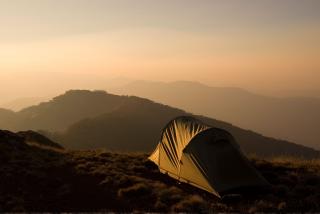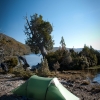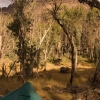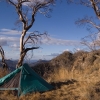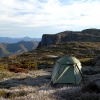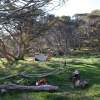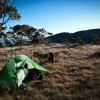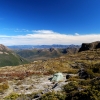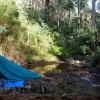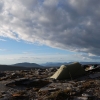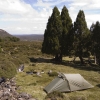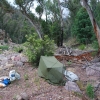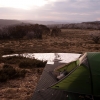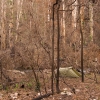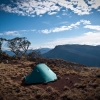This photo gallery is to show off some of the fantastic places I have pitched a tent. But there are one or two of these photos that give you an idea of how wonderful (indeed, life saving) it can be to have shelter.
Sometimes you don't need a tent. There are some hikes where a tarp is enough, depending on the season, the region and the insects. I have often just slept out in the open with nothing but the stars above me. But I do love sleeping in a tent. It's so much more home like than home. It's the full stop at the end of a day. It means shelter and comfort. Time to eat some food, read a book, relax and ponder on the day gone by and to consider the day to come. It is that blessed part of the hike where you don't wear boots, where you can stop to look around - even if that only means spying on what ever you can see from the tent flap. In bad weather there is no better thought than "I'm in here, not out there."
All in all you can say that a hike consists of eagerly packing away your tent every morning so you can get on with a great bush walk and then, just as eagerly, setting it up again so you can recover from your day of bush walking.
A good tent, good boots and a decent pack are the three things you should never skimp on if you take up hiking. Everything else you can compromise on. I have had my life saved by my tent many times. I once went to sleep on The Bluff in Victoria on a warm sunny autumn day and woke up wondering why my feet were so cold. Six centimetres of snow had silently fallen overnight.
Coming back along the plain after doing the Eastern and Western Arthurs Ranges, I once camped beside a creek on McKays Track. I was metres up and many metres back and it was an uncharacteristically hot day for South West Tasmania and not a cloud in sight. I was woken up the next morning by water splashing on my face. The creek had burst it's banks and water was splashing over the lip of the tent entrance. I jumped up and put my bare feet into my boots (one of which was only restrained from floating away by the tent annex), pulled the tent pegs and dragged the full tent to an island. Which rapidly went under as I frantically stuffed everything into my back. I sloshed (by now knee deep) back to where the tent had been to grab stuff that had been on the out side of the tent under the annex. Incredibly, all I lost was a water bottle.
On another occasion the weather turned spectacularly, awesomely, unbelievably bad as I was climbing up to the top of the Western Arthurs (you have to experience bad weather in south west Tasmania to believe it. No description is adequate). Not only was visibility nil but the wind, hail and sleet was coming in horizontally (and painfully) straight into my face. I was dangerously wet and cold by the time I got to the top and not a hope of putting more on without me and the inside of my pack getting a soaking. The nearest camp site was too far away. So I took the decision to set up on the ridge. It was the most exposed and unprotected place imaginable. The misery of getting that tent set up and thoroughly pegged down deserves it's own essay but I did it and spent a sleepless night on button grass humps. The horrendous wind kept deforming the tent poles all night so I kept getting smacked by the tent and the noise was tremendous. But I was dry (apart from what I tracked in). The tent survived it all and I stayed warm and safe.

